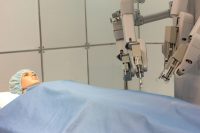Categories
- Additional Insured
- ChildrensProducts
- Claims Made
- Cyber Insurance
- Dietary Supplements and Nutraceuticals
- Ecigarettes
- Firearms Insurance
- Food Products
- Foreign Products Liability
- Foreseeable Misuse
- Frivolous Lawsuits
- General Liability
- Industrial
- Infographics
- Intellectual Property
- Looking ahead
- Marijuana Liability
- Medical Products
- Mutual Indemnification
- Nano Technology
- News
- Online Sellers Insurance Requirements
- Outsourcing
- Piercing The Corporate Veil
- Pollution Liability
- Product liability
- Product Recall
- Retail Chain Store
- Start-Up Business
- Statute of Repose
- Surplus Lines Insurance
- Technology
Robotics and Product Liability

Medical technology and the law
Surgical robots have been assisting surgeons for years now. However, we’re on the cusp of a new era in which fully-autonomous surgical robots will be actually conducting the surgery, not assisting.
The goals are less invasive surgeries, less pain and blood loss, and reduced risk and recovery times in the hospital for patients. But, as we’ve seen with driverless cars, such innovation isn’t without risk. it’s important to know whether patients are sufficiently protected under the current laws if something were to go wrong.
Who’s to blame?
Liability claims have already been brought against surgeons, hospitals, and manufacturers due to injuries that allegedly resulted from robot-assisted surgeries, such as infections and burns. Therefore, it will be imperative to look at the division and scope of liability when determining if fully-automated surgical robots provide offer the legal certainty for the safety patients need. Which of the parties involved in such claims would be liable if something goes wrong? The surgical team? The robot manufacturer and maintenance provider? The software developer? The hospital? The network and power providers?
Robotic surgery theaters are already being equipped with “black boxes” similar to those installed in aircraft, which record executed commands and movements. This enables forensic investigators to determine not only the cause(s) of the injury but who the responsible party or parties are.
What’s ahead?
We can expect that insurance will be used as the means for the parties in the robot-assisted surgery industry to manage their risks. This will be done through product liability insurance and medical negligence insurance or new insurance products specifically developed for the surgical robot industry.
Important legal and ethical issues aren’t keeping pace with the rapid advancements of medical technologies. It’s imperative that the potential implications of such technology be settled quickly by lawmakers.
The plus and minus of robotic surgery
While the benefits of robot surgery allow for less invasive procedures, more precise interventions and will allow for specialized procedures in parts of the world not normally conducive to specialized surgical procedures, there is an element of human error that cannot be avoided. Robots are expensive to maintain and can be incorrectly programmed. If the maintenance is not performed or the program is incorrect, it may be impossible to make adjustments on the fly, like a human surgeon can.
Source: Chris Holder and Vikram Khurana. “Rise of the Robot Surgeon.”www.bristowscookiejar.com. July 2016.
Posted By: Paul L. Owens-
 Click the Button Below to Get Your
Click the Button Below to Get Your
No-Obligation Quotes from Among the
Top 18 Leading Insurance Carriers Today -
Recent Industry News
- Amazon Sellers and Vendors Strategy Including Insurance Requirements
- Walmart Sellers Insurance
- Product Liability Limit Requirements of Online Sellers
- State-by-State Product Liability Analysis of Laws Impacting Businesses
- Children’s Product Liability: Strange Claims and Need for Insurance
- Product Liability vs. Environmental Insurance for the Chemical Industry
- Product Liability in the 3D Printing Industry: New Materials and Their Significance
- Product Liability Concerns in Agricultural Equipment Enhanced with Artificial Intelligence
- Navigate Product Liability in Battery and Solar Industry
- Cyber Risk Insurance Is Essential Business Insurance in Today’s Modern World
Monthly News Archives
